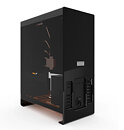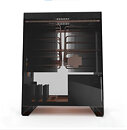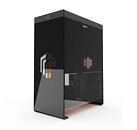Friday, September 25th 2020
MonsterLabo Announces The Beast
MonsterLabo, a maker of fanless PC cases, today announced its latest creation - The Beast. Featuring a design made from glass and 6 mm thick aluminium, the ATX case is resembling a design we usually could see only from the folks like InWin. The whole chassis is actually made up of two 3 KG aluminium heatsinks that feature ten 6 mm copper heat pipes each. All of this is used for heat dissipation and the case can accommodate up to 400 W of TDP in passive mode. When two 140 mm fans, running at 500 rpm, are added the case can cool more than 500 W of TDP. The Beast measures at 450 mm (L) x 380 mm (W) x 210 mm (H), making it for one large and heavy case. It supports graphics cards up to 290 mm in PCB length and is fully capable of supporting the latest NVIDIA GeForce RTX 30 series "Ampere" graphics cards. Pre-orders for The Beast are starting onOctober 9th, with an unknown pricing. You can expect it to be a high premium over 349 EUR price of The First case. Pre-orders will be shipping in Q1 2021.
Source:
FanlessTech



34 Comments on MonsterLabo Announces The Beast
The tempered glass blight has now infected radiators.
Glass is one of the best insulators there is, and it's now being used for passive cooling LOL.
Nice case I like it
Aesthetics aside this is an interesting case. The location of processor sockets and graphics chips tend to change from board to board - I wonder how MonsterLabo dealt with that. A full review with lots of pictures would be nice.
EDIT: I went to their site and the situation wasn’t any clearer.
EDIT: I'm not entirely sure what do you mean BTW. The case has 2 heatsinks both has the pipes' one end in the base and the other end in the heatsink. Not even a U-shaped configuration.
A heatsink sitting in the open connected to nothing does nothing.
I'm criticising the huge lost in conductive, heat-radiating surface area that the side panels normally perform. That's a non-trivial cooling mechanism being ignored in an era where 95W TDP actually means 200W and graphics cards are consuming 375W.
Maybe I'm not understanding the product here, but the 400W passive rating seems split equally between two separate fin stacks that connect via pipes to a plate - one for the CPU and one for the GPU. That means that this can handle a 200W CPU and a 200W GPU, passively, or "over 500W" which translates to "over 250W" for a GPU using a fan. How exactly is it going to cool a 3090, or even a 3080 for that matter, with only a 200W passive or 250W+ heatsink for the 375W card? They're short on cooling for the cards they claim, and they've hobbled the amount of heat the case can dissipate because of the glass.
If there's an asterisk next to the 30-series support that means it can fit a 3090 card in it, but can't cool a 3090 card using the case's own GPU heatpipes - then that's false advertising by my reckoning, and how they plan to passively cool the VRMs of a 3090 is something I'm looking forward to seeing tested. Additionally, if the card is permanently throttled by temperatures to, say, 300W instead of the 375W that the 3090 is tested as drawing, what's the point of even buying a 3090 in the first place, it's being crippled by the lack of cooling.
Don't get me wrong, I like MonsterLabo and think they make some of the nicest passive cases ever put to market, period. This, in my estimate, is pushing things a bit too far and glass is 100% not helping their cause here.
Now, let's think of the physical design of this. The case is clearly designed to have both the CPU and GPU oriented inwards, towards the inner heatsink, as both cold plates face outwards, one on each side. Any finned side panels would then need to connect around the component they're cooling (either GPU or motherboard) which would a) make for some really long heatpipes in the case of the motherboard (and long heatpipes aren't cheap!) b) limit motherboard support due to varying socket placements and VRM heatsinks inevitably making some motherboards foul the heatpipes, and c) making mounting the side panels entirely impossible. If the CPU and GPU both screw onto the inner heatsink from the back of the PCB, how would you get any sort of contact between any wraparound heatpipes and the side panel? You'd at the very least need several sets of notches on the inside of the side panels for the heatpipes to slot into, with visible screws on the outside to clamp things down, and even then you'd have an absolute nightmare in terms of actually getting the side panels on without applying significant force to your components. The chances of something breaking or a poor mount, if you could get the panels on at all, would be enormous.
Of course you could argue for designing a case without the internal heatsink and with finned panels instead, but ... that would be a completely different case. And one that already exists (well, it certainly looks like vaporware).
As for the cooling capacity, their site says 300W passively "per chip" (i.e. CPU and GPU, I guess), with more cooling capacity if you add the two optional 140mm top fans. So you won't be cooling a 3090 (and likely not a 3080 without throttling) passively, but pretty damn close. They have different, lower numbers for "recommended" passive cooling power, at 150W for the CPU and 250W for the GPU, which sounds like it would make more sense if you're looking for silence and decent temperatures. "Recommended" for active cooling (that's a <500rpm 140mm fan for each fin stack) is 250+320, though I'm guessing you can go higher if you speed up those fans some. As with any cooling solution of this nature, YMMV. As with all heatsinks, there's no magical "maximum cooling capacity" spec, it's all down to how you can and are willing to balance component thermals, airflow and noise. (There is of course a practical drop-off point where component thermals hit unsustainable levels no matter the airflow thrown at it, but that's likely high enough to not matter much here unless you're naïve enough to think you can overclock a 3080 or 3090 passively.)